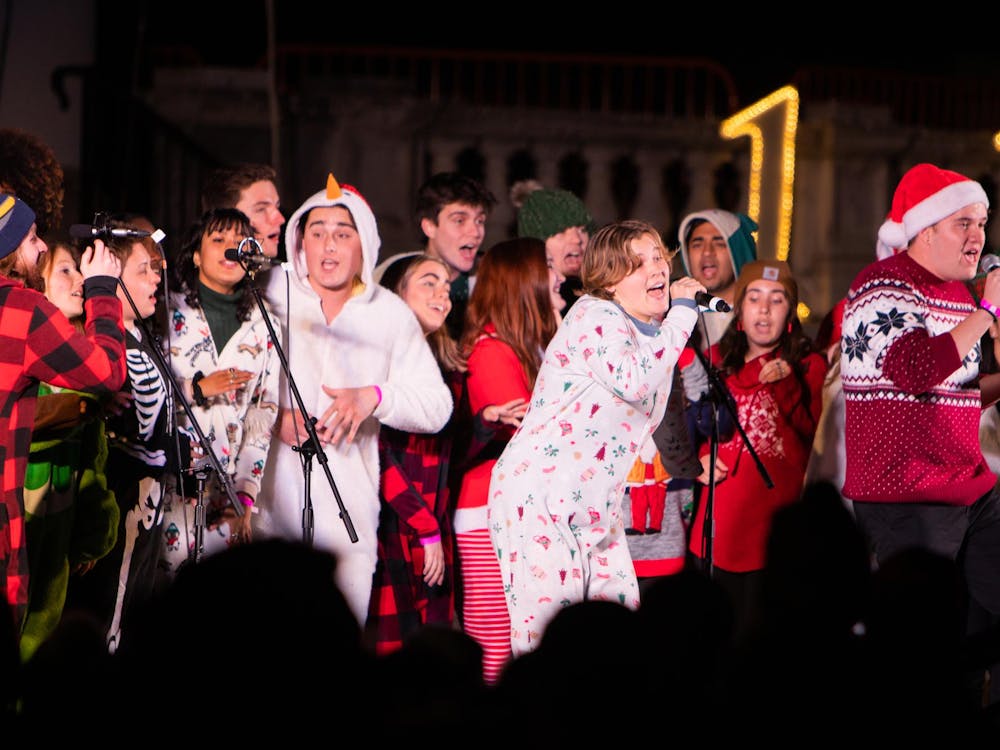From halfway across the world, University ROTC students are feeling the impact of the conflict in Kosovo.
Several decades after the booby traps and jungle military tactics of the Viet Cong forced the United States to develop new strategies in Southeast Asia, military science has once again undergone a dramatic facelift, this time in the wake of the crisis in the Eastern Europe.
Conflict in the Balkans and the peace- keeping efforts that followed there and in Kosovo introduced a new environment to U.S. troops: the urban landscape.
On this "complex battlefield," soldiers face the new challenges of peacekeeping in a land where civil authority may have collapsed, says Lt. Col. Will David.
Civilians and refugees could be in need of food, shelter or medical attention. Money from drug trafficking can be used to buy illegal arms that would further destabilize the area.
Because of the emergence of this more "complex" military landscape, the University's Army ROTC program now is adding a new facet to its cadet leadership development program.
David stresses that this emerging field of military tactics will be necessary to quell future conflicts in many countries as a large percentage of the world's population continues to flock to urban settings.
"We're not going to all hold hands and sing Kumbaya anytime soon," he said.
The first step in the University's new military approach came last Saturday, when, for the first time, the University's Army ROTC battalion participated in a tactical operation that focused on two aspects of urban warfare training: Military Operation on Urbanized Terrain (MOUT) and Stability and Support Operations (SASO).
The AROTC obtained permission to use the University-owned property of the defunct Blue Ridge Hospital, about a 15-minute drive away from the University off Route 20.
|
"At a minimum, we've gotten a taste of what we're going to be doing in the future," said cadet training and operations officer Phil Dickinson, who planned most of the exercises.
The SASO exercises involved setting up roadblocks and checkpoints to search vehicles for contraband. MOUT training largely consisted of clearing enemy resistance from buildings.
David, professor of military science and Cavalier battalion commander, saw a variety of benefits to the training, which he plans to implement once per semester.
All units of the Army eventually will rotate into a peacekeeping operation, says David, who was deployed to Albania and Kosovo in 1999. Introducing cadets to similar situations now is a realistic practice.
However, the MOUT and SASO training models also allow more cadets to serve in leadership roles than they are able to during the traditional light infantry tactical training.
"It's very much a problem-solving model," David said. "We really push the leadership to see how creative they are."
Mission: Possible
Barely inside the bounds of the Blue Ridge Hospital property, the AROTC cadets are gathered for a roadside intelligence briefing.
At 0900 hours on this Saturday morning Alpha Company, as the military science first- through third-year students are called, listens to the details of its latest mission, with notebooks and pens in hand.
Holding the brief, Cadet Battalion Commander Lauren Makowsky stands before the cluster of camouflage uniforms and black lace-up boots. To the left, a low-rising hill blocks any sign of the hospital complex they soon will infiltrate.
Flanked by a map of the fictional country in which they are operating, named Velorca, Makowsky outlines the disposition, composition and strength of Tazzaran enemies, natives of a neighboring country. It is a job not unlike the one she will have after graduation when she enters the Army's military intelligence branch.
"Enemy is armed with AK-47 assault weapons, M4s and M16s," she said matter-of-factly. "If engaged, the enemy will aggressively fight until they are about to be overtaken."
Alpha Company commander Phil Dickinson steps in shortly to deliver the rest of the operation order. Their mission, he says, is to "conduct peace enforcement operations" as well as to "fix and destroy enemy forces."
One platoon will establish a roadblock checkpoint where they are to "detain suspicious personnel vehicles."
A second platoon, armed with paintball guns, will seek to clear two buildings of equally armed OPFOR - opposing forces. They also may have to contend with loose floorboards, nails and other debris littering the hallways.
"Report emergency situations immediately," Dickinson instructed them.
A short back brief follows, where cadets cipher their scribbled notes into intelligible answers to Dickinson's questions - demonstrating their understanding of the mission.
Satisfied, the platoons are dismissed.
All the cadets have yet to see what awaits them over the hill.
Bird's eye view
Cadet Command Sgt. Maj. Ed Park's helm at the command post atop the hospital roof affords him a view of the entire hospital complex.
Overgrown brush and grass that looks like it has never been cut overwhelms the landscape.
A dilapidated mansion, complete with a caved-in roof and warped wooden window frames, lords over the smaller house structures that dot a sloping hill. Their disrepair echoes that of the mansion -- rusted tin roofs and peeling paint evoke the same sense of abandonment.
Beneath a few scraggly pines the OPFOR, otherwise known as fourth-year cadets in black T-shirts, wait patiently for their exercise in urban warfare to commence. The platoon conducting the mission is still preparing somewhere, hidden by a thick grove of evergreens.
For now, Park has his binoculars trained on the operation that is underway.
Crouched beneath a hip-high wall that encloses the roof, he peers at the platoon conducting the checkpoint along a narrow drive adjoining a parking lot.
One of Park's duties at the command post is to maintain radio contact with the patrol leaders of the two platoons. For this purpose, a camouflage green PRC 77 radio is planted at his side.
"This is what they used in the Vietnam War," he explained, a testament to the boxy radio's worn, antiquated look. "The army doesn't use this anymore."
In the parking lot below, the cadets have detained a white jeep, and all its doors are open as the driver and passenger mill about.
"They caught some civilian with marijuana so they're searching the vehicle," says Brendan Dignan, serving as the day's Public Affairs Officer. "It's testing the cadets' ability to challenge the driver."
The OPFOR in the checkpoint situation are instructed to be belligerent to the cadets, and throughout the morning the fourth years employ a range of tactics to keep the cadets on their toes: mouthing off, acting high, speaking in Spanish and even sign language. All of this challenges the cadets to gauge an appropriate response.
The cadets don't have long to wait before their SASO skills are tested. The midmorning stillness is suddenly shattered as the one of the civilians runs screaming nonsense across the parking lot.
Shouts of "Get her!" and "Ma'am!" urge the cadets to action, but the woman nearly makes it across the whole lot before anyone catches her.
"It's probably not a good thing that she got that far," Dignan joked.
Ground forces
Back on the ground, the second platoon has positioned itself in the tall grasses across from Building 1915. Wearing paintball masks and carrying their "weapons," most members of the platoon cross the short distance to the red brick house in a low running crouch until they reach an open window. From this point they must enter and "clear" the building of OPFOR, one room at a time.
Inside the darkened structure, the cadets clear the first floor, but they stop dead in their tracks nearly as soon as they try to venture up the staircase.
An abrupt volley of red paint balls hits and splatters instantaneously against the white wall of the stairwell landing.
"If you're dead don't say nothin'," yells Master Sgt. Kim Brewton to those who were hit.
The "wounded" casualties are dragged into a cleared room as the exercise continues, but during the After Action Review outside, it's apparent that the red liquid drying on some of a cadet's temple isn't just paint.
Before repeating the drill in Building 1916 next door, Brewton reviews with the cadets what happened, what should have happened and why.
"The main thing I want to stress is, team leaders, control your team," he says.
They'll get one more chance.
Time out
By early afternoon, the training and the heat look like they've taken their toll on the cadets who are still dressed in their camouflage pants and long sleeves.
David wants them to leave on time, but not before he reiterates the main points of the day.
"You're not experts taking down a building," he reminded one of the platoons having just completed its SASO exercise. But, he asked them, "Do you improvise? Do you adjust?"
With questions like these, David wanted his cadets to consider the causes and consequences of their mistakes during the SASO and MOUT operations.
"You need to know what you did wrong to get better," he said.
Although the AROTC platoons essentially used role-playing and paintballs as a substitute for real-life conflict in a place like Kosovo, the lessons the cadets hope to learn from exercises such as this one nevertheless apply to realistic military situations.
"Don't think we have a cavalier attitude toward death. We do not," David said. "That's not the goal to get Joe killed"




